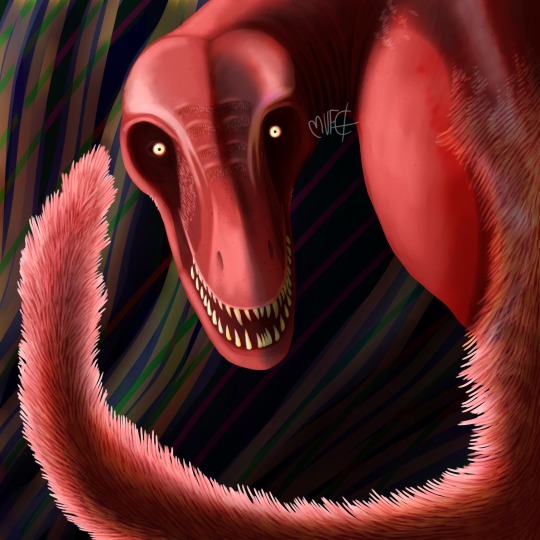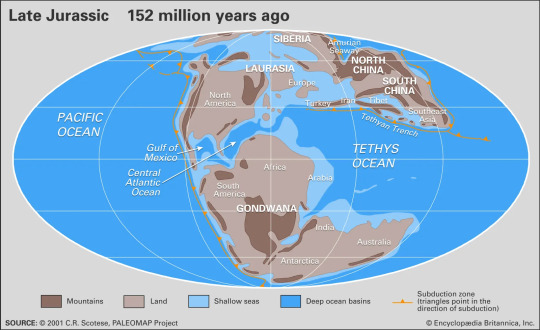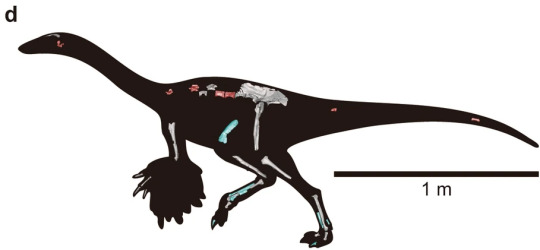#tyrannosauroids
Text

How the hell did they get up there?
#art#my art#digital art#paleoart#paleontology#palaeoblr#archosaurs#dinosaurs#theropods#coleurosaurs#tyrannosauroids#dilong#dilong paradoxus
40 notes
·
View notes
Text

Heyoooo! First post on this new sideblog.
As much as bearded vultures are not only my favorite dinosaur, but my favorite animal in general, I feel like non-avian dinosaur designs using bearded vulture colors and markings are extremely overdone. 😅 However… I am in the midst of making new avatars for all my blogs and I want them to all have the same theme (bearded vulture). Which I guess means I gotta put bearded vulture markings on another dino. For this, I have chosen Yutyrannus huali.
#Yutyrannus huali#Yutyrannus#tyrannosauroids#tyrannosaurid#theropods#saurishcians#dinosaurs#archosaurs#archosauromorphs#reptiles#Yixian Formation#Early Cretaceous#China
25 notes
·
View notes
Text
Dinofact #106
Bistahieversor, a tyrannosauroid dinosaur, differs from other tyrannosaurs in that it possesses 64 teeth, an extra opening above the eye, a keel along the lower jaw, and a complex joint at its forehead, among other unique traits. The dinosaur, discovered in 1990, was originally thought to be an Aublysodon, then a new species of Daspletosaurus, before being assigned its own species, Bistahieversor sealeyi, in 2010.
Source: Wikipedia
#dinosaur#dinosaurs#paleontology#bistahieversor#bistahieversor sealeyi#tyrannosaur#tyrannosaurs#tyrannosauroid#tyrannosauroids#tyrannosauroidea#aublysodon#daspletosaurus#fun facts#trivia#dinosaur trivia#dinosaur fun facts#14th#december#2022#december 14th#december 2022#december 14th 2022
8 notes
·
View notes
Text

Dilong!
143 notes
·
View notes
Text

Just Komik by Harashu (@Harashu96 on Twitter) (Via TroodonVet on Twitter)
#Me and who#Just Komik is his series if this pic has particular title please let me know#Dinosaur#Wedding#Coprolite posting#the dream#Jurrasic Park#Jurrasic World#Tyrannosaurus Rex#Tyrannosauroid#indominus rex#Velociraptor x Tyrannosaurus#Theropod#Harashu#Indonesia#Comic#Just Komik#Dinosaur Wedding#Romance#Paleo nerd#Paleoblr#Dinosaurs#Indonesian artist
63 notes
·
View notes
Text

I've been trying forever to find this old digital painting I did of a tyrannosauroid dino from December 2020 and I finally did!!
#mvf art#digital painting#digital art#i'll eat my hat if i find that i already posted this but-#paleoart#tyrannosauroid#tyrannosauroidea
17 notes
·
View notes
Text
Dinosaur Profile: Stokesosaurus

An early relative of the great Tyrannosaurus rex, Stokesosaurus provides a window into the early history of the infamous Tyrannosaur family and a new perspective of the giants to be.
Background
Stokesosaurus was described in 1974 by geologist James Henry Madsen amid various Allosaur specimens collected at the famous Cleveland-Dinosaur Quarry in Emery County, Utah as part of the equally famous Morrison Formation. The Morrison Formation dates back to the late Jurassic Period from 156-146 million years ago. It was in these rocks that famous dinosaurs such as the aformentioned Allosaurus, Stegosaurus, Apatosaurus, Brontosaurus, and Brachiosaurus were discovered all the way back to the infamous Bone Wars.

North America during the Late Jurassic almost resembled that of today, having broken apart from Africa and South America during the breakup of the supercontinent Pangea. Instead, it was part of a supercontinent that is referred to as Laurasia along with North and South China, while South America, Africa, India, Australia, and Antartica were joined together in the southern Gondwana.
Due to the formation of new coastlines with the birth of the new Atlantic, the once arid deserts became dominated by coastal rainforest and rich savannahs. With so much greenery to go around, it provided the perfect habitat for dinosaurs to become giants.

Late Jurassic Utah was not without its challenges though. Dry seasons were especially harsh with water being a scarce resource. Species that couldn't migrate were forced to congregate at ever shrinking pools of water, which could dry up completely in particularly bad seasons. These became hazardous as desperately thirsty animals would either find themselves trapped in thick mud to be preyed upon by predators, or just die from dehydration being unwilling to leave their water source.
The Cleveland-Quarry is one of these traps. Over time, the returning waters from the wet season would quickly bury dead carcasses and preserve them for generations to come. Allosaurus was a surprisingly common find here, probably attracted to the scent of rotting meat, with unlucky individuals becoming stuck as well.
It's among the specimens of Allosaurus that Stokesosaurus would be identified, likely drawn by the same desperation that spurned many a carnivore to their death.
Evolutionary History

Stokesosaurus clevandii is considered part of what is referred to as Pantyrannosauria: a group that is more advanced than the more primitive Proceratosaurs that includes Guanlong, an often-cited tyrannosaur ancestor. Proceratosaurs and early Pantyrannosaurs were small to medium-sized predators, often overshadowed by the larger allosaurs. Believed to have migrated to North America from Asia.
They in turn are members of the coelurosaur family that first evolved from around 160 million years ago. Coelurosaurs are dinosaurs that are most closely related to birds, such as dromaeosaurs and the tyrannosaurs themselves. Small and lightweight, they were able to feed primarily on small game and avoid direct competition with larger predators.
Description

What little we have of Stokesosaurus clevelandi (Stokes' Lizard of Cleveland) are mainly fragmentary remains. The most complete and intact specimen is UMNH 2938, which consists of a left hip bone. It's believed to belong to a juvenile, with the lower picture being scaled to a probable adult.

With an estimated length of 3 to 4 meters when fully grown, Stokesosaurus was a pint sized predator. Far smaller than the more famous giant herbivores that populated prehistoric Utah. This would've restricted its diet to smaller game such as rodents or young dinosaurs small enough to attack. To catch agile prey such as these, it's likely Stokesosaurus's light frame would've allowed it to be fast and agile themselves.
Being small and fast would also allow it to deal with the larger and more ferocious allosaurs. Stokesosaurus would've simply been too scrawny and small to make a proper meal out of, so they were more than likely not worth the effort needed by the larger predators to catch them. The most contact the two groups would've had would be during feedings where the smaller Stokesosaurus would easily be chased off by the larger allosaurs. Not before taking a few bites from the carcass themselves first of course.
Surviving Among Giants

Despite being in the low end of the food chain, there are certain advantages to being small. For starters, a small body mass requires less amounts of food to maintain. Meaning Stokesosaurus can afford to spend less time hunting and expending energy.
A lesser need for food also means a lesser need for territory and a steady supply of meat. Big predators often need wide territories in order to maintain their immense size. And with such a high demand in food and space, means competition for territory can be fierce and often dangerous. Small predators like Stokesosaurus avoid this problem by not having a need for such wide territories.
Life for a big predatory dinosaur was rough. Between having to hunt dangerous big game and contend with rivals for large territories, many large predatory dinosaur remains have evidence of injury. The famous Allosaurus specimen MOR 693 or "Big Al" was discovered to have evidence of 19 broken bones throughout his life, with signs of an illness being his cause of death. Stokesosaurus may have been able to avoid this fate by going after smaller game and having a reduced need for territory, thus reducing the threat of deadly competition. Living small and avoiding life threatening battles or hunts probably allowed Stokesaurus and other early tyrannosaurs to thrive under the shadows of giants. Until they were able to become the famous predators known the world over
Pop Culture

Stokesosaurus has a very minimal presence in media, though it does make a noticeable appearance in the Zoo Tycoon 2: Extinct Animals expansion pack. Players are able to adopt Stokesosaurus to add to their zoo as a 1 1/2 star animal. Here it has been beefed up in size to a medium sized carnivore with a large enclosure requirement and is treated as an apex predator similar to Tyrannosaurus rex.

There is also an easter egg of sorts related to Stokesosaurus. If a painting easel is placed within its enclosure as a toy, it'll put on a pair of glasses and paint on the easel, similar to an elephant.
Sources:
Jurassic Period - Geology Page
(PDF) The dinosaur death-trap of the Cleveland Lloyd Quarry, Emery County, Utah | ResearchGate
The phylogeny and evolutionary history of tyrannosauroid dinosaurs | Scientific Reports (nature.com)
Stokesosaurus (prehistoric-wildlife.com)
The Systematics of Late Jurassic Tyrannosauroid Theropods from Europe and North America
Review of Pathologies on MOR 693: An Allosaurus from the Late Jurassic of Wyoming and Implications for Understanding Allosaur Immune Systems
Artists
Stokesosaurus by Tom Parker from Wikipedia
Jurassic Period Paleogeography from Britannica
Cleveland-Lloyd Dinosaur Quarry by Mark Ostler from visitutah.com
Stokesosaurus clevelandi: Stokes' lizard by Paleonerd01 from deviantart
Stokesosaurus from prehistoric-wildlife.com
Evan Johnson-Ransom from twitter
Zoo Tycoon 2 pics taken from Zoo Tycoon wiki
#Stokesosaurus#tyrannosaur#tyrannosauroid#dinosaur#dinosaurs#paleontology#zoo tycoon 2#art not by me#please support the artist
27 notes
·
View notes
Text

"...THE SKULL AND PELVIS PLACE IT IN THE TYRANNOSAUROID SUPERFAMILY. LIKE MANY OTHER THEROPODS, IT ALMOST CERTAINLY HAD FEATHERS."
PIC INFO: Resolution at 1387x1387x1913 -- Spotlight on the Guanlong wucaii, a small to mid-sized early tyrannosaur and a member of the family Proceratosauridae. Unlike your typical tyrannosaur, Guanlong wucaii had long arms and three-fingered hands for grabbing and ripping. But the shape of its teeth, and features in the skull and pelvis place it in the tyrannosauroid superfamily. Like many other theropods, it almost certainly had feathers. Artwork by William Stout, c. 2009.
Genus: Guanlong
Species: wucaii
Family: Proceratosauridae
Super Family: Tyrannosauroidea
Suborder: Theropoda
Order: Saurischia
Superorder: Dinosauria
Class: Reptilia
Subphylum: Vertebrata
Phylum: Chordata
Kingdom: Animalia
Pronounced GWON-long woo-kay-eye
INTRODUCTION: "Named from the Chinese words guan, meaning "crown," and long, meaning "dragon," in reference to its flashy head-crest, the most elaborate of any known theropod dinosaur. The species name comes from the Chinese word wucai meaning "five colours" and refers to the multi-hued rocks at Wucaiwan, the badlands where the fossils were found.
Guanlong wucaii is one of the most primitive tyrannosaurs known. It hunted its prey 95 million years before T. rex lived."
-- AUSTRALIAN MUSEUM, Dinosaurs and their Relatives/Dinosaur Fact Sheets
Source: www.pinterest.com/pin/504614333230272954 & https://australian.museum/learn/dinosaurs/fact-sheets/guanlong-wucaii.
#Guanlong#CrownedDragon#Palaeoart#DinosaurArt#DinoArt#WilliamStoutArt#WilliamStout#FeatheredDinosaur#Tyrannosauroid#Theropod#Dinosaur#FeatheredDinosaurs#GuanlongWucaii#Dinosaurs#Wucaiwan#Tyrannosaur#TyrannosauroidSuperfamily#Watercolors#PrehistoricArt#Prehistoric#Prehistory
1 note
·
View note
Photo

Guanlong, one of if not my favorite tyrannosauroid
990 notes
·
View notes
Text
Yutyrannus

Yutyrannus is the largest dinosaur discovered with direct evidence of feathers. It is a large basal tyrannosauroid, growing to about 9 m in length, and weighing around 1.5 t. Yutyrannus is known from three nearly complete individuals: an adult, subadult, and a juvenile. Because they were found together, it is theorized that they may have hunted in packs. Adults sported a high midline crest on the snout, as well as one above each eye. Unlike more derived tyrannosaurs, Yutyrannus had long forearms with three fingers on each hand. Feathers in the fossil specimens are present on various parts of the bodies of all three individuals, implying total coverage.
127 notes
·
View notes
Text
Tyrannomimus fukuiensis Hattori et al., 2023 (new genus and species)

(Schematic skeletal of Tyrannomimus fukuiensis showing preserved bones, from Hattori et al., 2023)
Meaning of name: Tyrannomimus = tyrant mimic [in Greek, referring to the similarity of its hip bones to those of tyrannosauroid theropods]; fukuiensis = from Fukui
Age: Early Cretaceous (Aptian)
Where found: Kitadani Formation, Fukui, Japan
How much is known: Two partial skeletons and many isolated bones including parts of the skull, vertebrae, and limbs. It is unknown which of these bones belonged to the same individuals, but multiple individuals are represented.
Notes: Tyrannomimus was an ornithomimosaur, a group of superficially ostrich-like theropods. It is the first ornithomimosaur to be named from Japan, and may have been closely related to the bizarre, giant Deinocheirus from the Late Cretaceous of Mongolia, though it was much smaller.
Intriguingly, Tyrannomimus also exhibits similarities to another theropod, Aviatyrannis, the type specimen of which is a partial hip from the Late Jurassic of Portugal. Aviatyrannis has traditionally been considered a possible tyrannosauroid, but the resemblance to Tyrannomimus raises the possibility that it may instead have been an ornithomimosaur, in which case it would be the oldest known member of this group.
Reference: Hattori, S., M. Shibata, S. Kawabe, T. Imai, H. Nishi, and Y. Azuma. 2023. New theropod dinosaur from the Lower Cretaceous of Japan provides critical implications for the early evolution of ornithomimosaurs. Scientific Reports 13: 13842. doi: 10.1038/s41598-023-40804-3
166 notes
·
View notes
Text

Messing around with coloured pencils. Basically I stuck my hand into my pencil case, grabbed a few pencils at random and used those to colour in a drawing. I got a quite natural-looking colour scheme this time round but hopefully I'll get weirder colour palettes in the future. Dino is Daspletosaurus torosus btw.
#art#my art#traditional art#pencil drawings#coloured pencils#paleoart#archosaurs#dinosaurs#theropods#coleurosaurs#tyrannosauroids#tyrannosaurs#daspletosaurus#daspletosaurus torosus
20 notes
·
View notes
Text
anything I didn't mention just pick the closest thing (compsognathids put with weird floofs, basal Neornithischians with Ornithopods, etc)
175 notes
·
View notes
Text
Dinofact #40
Proceratosaurus, a small theropod carnivore, was originally thought to be an ancestor of Ceratosaurus, due to the crest on its head resembling that of Ceratosaurus. However, it is now considered a coelurosaur, specifically a member of Proceratosauridae, whereas Ceratosaurus is a Ceratosaurid. Proceratosaurus may be one of the earliest members of Tyrannosauroidea.
Source: wikipedia [1], [2]
#dinosaur#dinosaurs#paleontology#proceratosaurus#ceratosaurus#theropod#theropods#theropoda#coelurosaur#coelurosaurid#coelurosauria#tyrannosaur#tyrannosauroidea#tyrannosauroids#tyrannosauroid#ceratosaurid#ceratosaurids#ceratosauridae#ceratosauria#fun facts#trivia#dinosaur trivia#dinosaur fun facts#3rd#october#2022#october 3rd#october 2022#october 3rd 2022
8 notes
·
View notes
Text

A dinosaur tooth of an indeterminate theropod from the Itat Formation in Krasnoyarsk Krai, Russia. Although labeled as Kileskus aristotocus, the odd absence of a mesial carinae suggest it may not be proceratosaurid, or even tyrannosauroid. Unfortunately there are not many papers published on isolated teeth from these Middle Jurassic deposits, and this particular morphology does not seem to correspond to any known clade.
#dinosaur#fossils#paleontology#palaeontology#paleo#palaeo#kileskus#proceratosauridae#tyrannosauridae#theropod#jurassic#mesozoic#prehistoric#science#paleoblr#キレスクス#プロケラトサウルス科#ティラノサウルス科#恐竜#化石#古生物学
43 notes
·
View notes
Text
*adult* t-rex is now pretty widely thought to have been too large to have feather coverage - animals that size risk overheating, like the elephant 🐘. like the elephant having a sort of peach fuzz it's not impossible it may have had a coating of protofeathers as in some tyrannosauroids, which is the basis of some of the arguments that t-rex is at least covered in protofeathers - though keep in mind these are manmade phylogenetic brackets. we have skin / scale impressions from multiple parts of the t rex body now, which doesn't preclude patches of feathers but again, in conjunction with the previous idea and the absence of any evidence OF feathers on an adult t-rex, means that the current theory you'll mostly see around is no major feathers unless proven guilty. 'scientifically accurate dinosaurs' are not so concretely this or that as you will see people 'um actually'-ing about -- so much of what we can try to say about dinosaurs is out of inference and comparison. all the same i think there is a certain pop culture shortcut that any feathers slapped on any dinos is the smarter, more scientifically accurate approach and not only does Scientifically Accurate Dinosaur as a phrase sometimes go the self-assuredly unnuanced way of Biblically Accurate Angel but like. well im nuts so it doesnt matter
39 notes
·
View notes